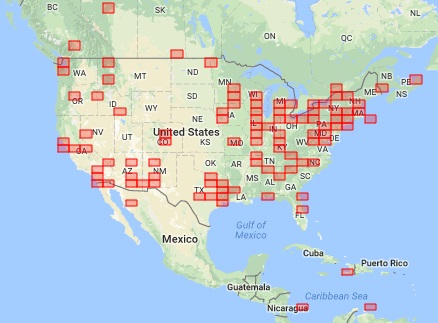 As I previously posted, during 2018, the ARRL is conducting an Amateur Radio event known as the International Grid Chase. The event is a friendly competition to see who can work the most grid squares on any band or mode.
As I previously posted, during 2018, the ARRL is conducting an Amateur Radio event known as the International Grid Chase. The event is a friendly competition to see who can work the most grid squares on any band or mode.
A grid square is a division of the earth into sectors one degree latitude by two degrees longitude. Each one is designated by a four character identifier. For example, I live in EN34
After I wrote my previous post, the official rules for the event were announced. And contrary to my initial interpretation, it is important to work grids on as many bands and modes as possible, since points are awarded for each grid on a new band or mode.
With my modest station, I’m certainly not in the big leagues. But with a very modest effort, I now have 100 grids confirmed, as shown on the map above. And because I have some of them confirmed on more than one band or mode, I have a total of 162 points, placing me in about 1953rd place out of 17287. That places me in about the top 11%, which I consider to be respectable given a modest station and limited time.
Interestingly, on a later update of the Leader Board shortly after writing this, I see that I am now tied with W1AW for 1928th place. Strangely enough, this is the second time I’ve been tied with the ARRL’s Headquarters station:
Points are awarded as the contact is confirmed on Logbook of the World (LOTW). Since confirmations continue to filter in, this score will continue to rise.
Most of my contacts so far came from two contests, the CW and SSB weekends of the North American QSO Party. A majority of contesters seem to participate in LOTW. Therefore, by making as many contacts as possible, the score continues to rise. As you can see from the map above, most of my contacts are from the United States, with a smattering of contacts from Canada, Mexico, and the Caribbean. The handful of European contacts I’ve made so far have not yet confirmed on LOTW.
So far, I have no digital contacts. So at the very least, I’ll need to get set up for PSK31, which requires only very minimal hardware between the computer and radio. Every contact I make will be worth one point, since I have yet to work any grids in a digital mode.
Two upcoming contests are worthy of note. Next weekend is the Minnesota QSO Party, which has participation in all or most Minnesota counties. It will be a good opportunity to get the 26 grids which lie completely or partially in Minnesota. Other state QSO parties later in the year will provide similar opportunities.
And the ARRL DX Contest (CW in February and SSB in March) will provide a lot of new grids, since almost everything outside the U.S. will be new for me.
To follow your own progress, a good tool is the N1KDO Grid Mapper, which was used to generate the map at the top of the page. When I started as a Novice, one common activity for new novices was to color in a “Worked All States Map,” which was nothing more than an outline map of the United States. The process of coloring in a map can be addictive, and I often find myself refreshing the map to see if other confirmations have come in, with another square turned red.

